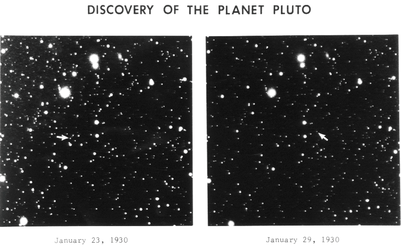Pluto celebrated its 80th birthday on 18th of this month. Yes, 80 yrs since Clyde Tombaugh discovered the then farthest object of our solar system.
Using Newtonian Mechanics, Neptune's position was predicted before its discovery after analyzing the perturbation in the orbit of Uranus. After Neptune's discovery it was found that the Uranus' orbit was disturbed by another object other than Neptune. The start for the search of a new planet started in 1905 and it took nearly 25 yrs to discover it. Pluto was discovered just like any other planet - by relative movement.
Pluto was so far that it was impossible to identify its diameter or mass. At first it was believed that Pluto was larger than Mercury. Pluto was considered to be the ninth planet of our Solar System until August 2006 when International Astronomical Union (IAU) brought out a definition for the term 'Planet' for the first time and thus Pluto was added in to the list of 'Dwarf Planets' along with the others discovered beyond the orbit of Neptune.
Pluto is now a distinct member of the Kuiper Belt (Similar to Asteroid Belt but this one is found beyond Neptune's Orbit). Three satellites were discovered orbiting Pluto namely Charon, Nix and Hydra.
Dog or Planet:
There is a very famous question which had been asked very often. Which came first? The Dog or the Planet? Pluto, the famous Disney Dog, as well as the planet Pluto were created/discovered in 1930. Some say that the dog was named after the planet and some say that the planet was named after the dog. The question which started in 1930 was answered only in 2006. Venetia Burney (who was 11 yrs old in 1930) was the one who suggested the name Pluto for the planet. It was believed that she was fascinated by the cartoon character Pluto and suggested the same name for the planet. But in 2006, the 88 yr old Venetia said, "The name had nothing to do with the Disney Cartoon. Mickey Mouse's dog was named after the planet, not the other way around."
23 February 2010
15 February 2010
Picture Of The Month - February 2010
The brilliant fireball meteor, as bright as the full moon was captured in this snapshot over the city of Groningen, Netherlands on October 13th, 2009. The sightings of the meteor were widely reported throughout the Netherlands and Germany at approximately 17:00 UT. Accompanied by sonic booms and rumbling sounds, the meteor was seen to break up into bright fragments, eventually leaving a persistent smoke-like trail. Even though there are bright fireball meteors in planet Earth's atmosphere every day, sightings of them are relatively rare because they more often occur over oceans and uninhabited areas.
9 February 2010
Annular Eclipse
If you had read my post on Solar Eclipse, you would have known that Annular Eclipse is a type of Solar Eclipse where the moon does not block the entire Sun. If you had read my last post about the eclipses, I had mentioned that on Jan 15th, 2010, India would witness an Annular Eclipse. It was the first in India after 108 years.
An Annular Eclipse is when the Solar Eclipse occurs when the moon is smaller than its average size. Due to this, the moon does not block the entire sun and forms a ring.
For the first time of my life, I felt the effect of an eclipse. The day was bright as it always is in Chennai when the brightness began reducing. One can still feel the heat of the sun yet the brightness alone had reduced as if a very very thick cloud had blocked the sun.
Below is the formation of the annular eclipse as taken from Chennai on 15th January, 2010.
The next solar eclipse in India would be on 26th December 2019 which would again be an annular eclipse. It will be experienced through out the South India and Sri Lanka.
An Annular Eclipse is when the Solar Eclipse occurs when the moon is smaller than its average size. Due to this, the moon does not block the entire sun and forms a ring.
For the first time of my life, I felt the effect of an eclipse. The day was bright as it always is in Chennai when the brightness began reducing. One can still feel the heat of the sun yet the brightness alone had reduced as if a very very thick cloud had blocked the sun.
Below is the formation of the annular eclipse as taken from Chennai on 15th January, 2010.
The next solar eclipse in India would be on 26th December 2019 which would again be an annular eclipse. It will be experienced through out the South India and Sri Lanka.
Subscribe to:
Posts (Atom)




